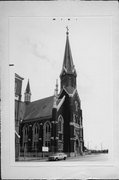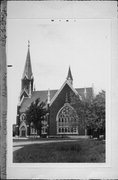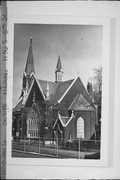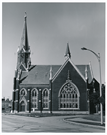| Additional Information: | A 'site file' exists for this property. It contains additional information such as correspondence, newspaper clippings, or historical information. It is a public record and may be viewed in person at the Wisconsin Historical Society, State Historic Preservation Office.
SEE WALKER'S POINT FILE. See H.O.W. Site File.
The 1901 St. Stephen's Church was designed in the High Victorian Gothic style by Otto C. Uehling. It is a good but late example of this richly ornamented form. The tower and spire were constructed in 1879 for an earlier building. Milwaukee Landmark.
The congregation dates to 1854, when south side members of Kilbourntown's Trinity Lutheran Church established St. Stephen's.
With its pointed arches and soaring sense of verticality, St. Stephen's recalls the other Gothic Revival churches built in the late nineteenth-century. At the same time, St. Stephen's is untraditional in being Milwaukee's first steel-framed church building. Large north- and south-side transept windows, with their spiky Gothic tracery, highlight St. Stephen’s elaborate exterior. The church's symmetrical composition and towering central steeple are typical of Milwaukee's German-inspired Gothic Revival ecclesiastical architecture. Its steeple was built in 1879 as part of the earlier church, and retained when the church body was rebuilt in 1902. The steeple houses one of the Midwest's few operational, weight-powered tower clocks.
St. Stephen's richly finished interior boasts an intricately carved, natural oak altarpiece, and a fine pipe organ, its ranks of pipes concealed behind a paneled oak case. Sunlight shimmers through a rich palette of colors in the large stained-glass transept windows. By night, scores of bare electric light bulbs, arranged in a starburst pattern on the arched plaster ceiling illuminate the nave.
1973: "This colorful, vivacious Gothic Revival church edifice was erected for the south side's second Lutheran congregation, organized by German-speaking members of this denomination in 1854. It is the fourth church occupied by the congregation...incorporates the tower and spire of their third church fabric. Inside and out, the church looks much as it did... in 1902.
Alterations and Additions (as of 1973):
As indicated , the present church incorporate the tower and spire of and earlier St. Stephen's Church--specifically, the tower and spire added in 1879 to the church built for the congregation in 1866. When the new fabric was erect in 1901-02, the older tower and spire were veneered with Indiana brick and trimmed with Bedford stone to match the early 20th century construction. Since 1902 there have been only minor changes to the interior, most recent of them, apparently, carried out on the occasion of the congregation's centennial in 1954. At this time the original pulpit was removed and the interior redecorated.
Builders: William Zieman, carpenter; American Bridge Company, iron contractor; Albert Koening and Son, masons."
"Architect Uehling's Gothic Revival design for St. Stephen's Lutheran Church is unusually vivacious and ornamental for the date, when more subdued versions of the Gothic were in vogue; and it is further enlivened by the exterior color scheme in which gray and ivory foundation and trim contrast for a congregation whose history dates back to 1854, when south side members of Kilbourntown's Trinity Lutheran Church established St. Stephen's." Pagel, Mary Ellen & Virginia A. Palmer, University Extension University of Wisconsin, Guides to Historic Milwaukee: Walker's Point and South, 1969. |
|---|
| Bibliographic References: | A. PLAQUE.
B. DATE STONE.
C. MILWAUKEE HISTORIC BUILDINGS TOUR: WALKER'S POINT (COMMERCIAL), CITY OF MILWAUKEE DEPARTMENT OF CITY DEVELOPMENT, 1994.
Pagel, p. 17.
National Register Nomination Form.
Buildings of Wisconsin manuscript.
"Centennials," The Lutheran Witness, LXXIII, August 17, 1954, 1.
History of Milwaukee, Chicago, 1881, 908-909, 934-935.
Pagel, Mary Ellen and Palmer, Virginia A., Guides to Historic Milwaukee: Walker's Point and South, Milwaukee, 1969, 16-17.
Palmer, Virginia A. and Wietczykowski, Mary Ellen, Walker's Point: Two Walking tours, Milwaukee, 1972, 27, 29.
Peterson, Peg, "St. Stephen's Evangelical Lutheran Church," Walker's Point Preservation District Inventory prepared for Land Ethics, Inc., Milwaukee, 1970, and sources cited.
Historic Walker's Point, Inc., A Guide to Historic Walker's Point, 1978.
Pagel, Mary Ellen & Virginia A. Palmer, University Extension University of Wisconsin, Guides to Historic Milwaukee: Walker's Point and South, 1969. |
|---|





